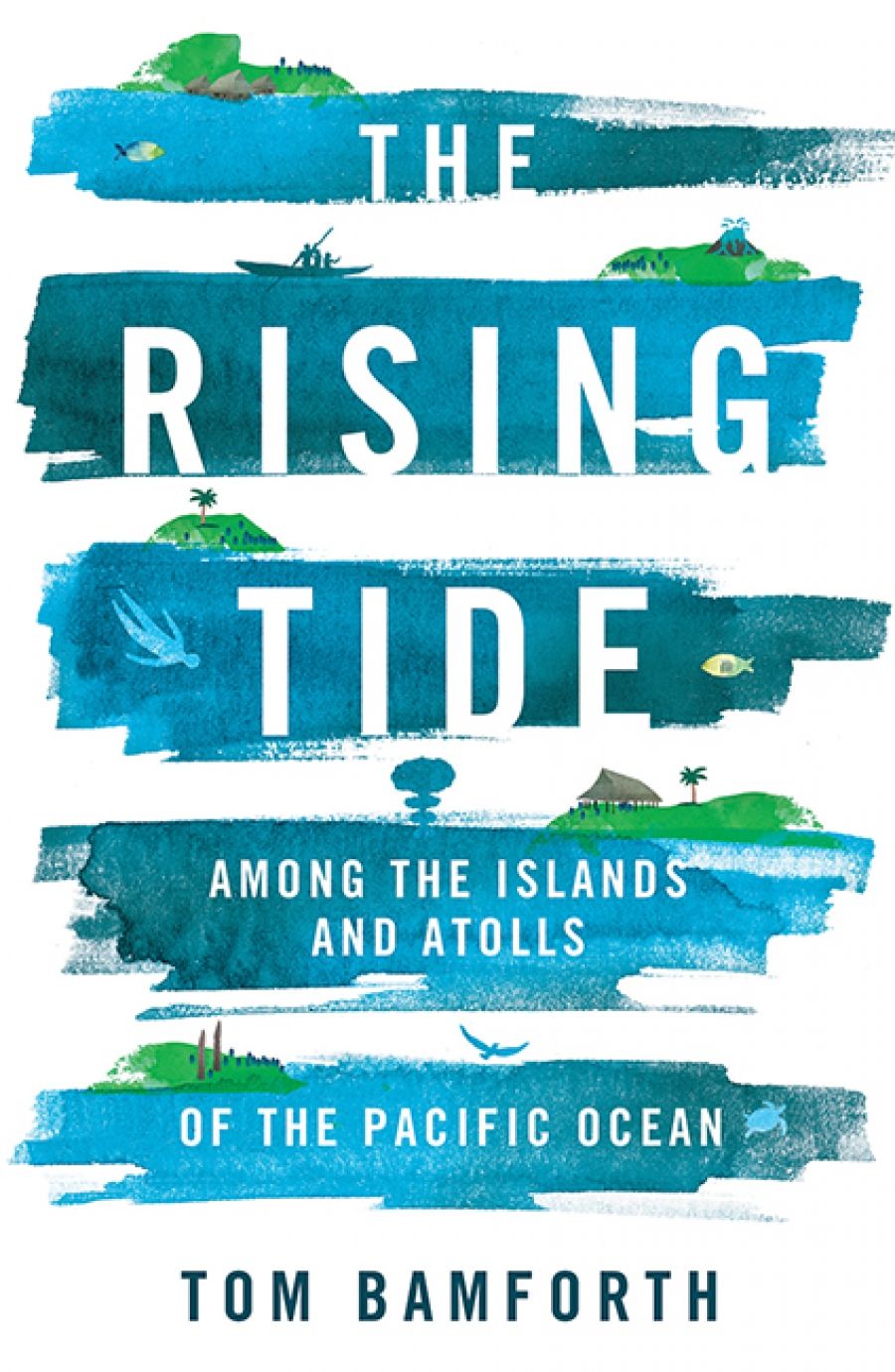
- Free Article: No
- Contents Category: Environmental Studies
- Review Article: Yes
- Custom Highlight Text:
During cold southern winters, the islands and atolls of the Pacific seem to offer an idyllic escape. Advertisements for cheap flights to Fiji or New Caledonia present smiling ukulele players and al fresco massages. More bleakly, despairing islanders, by virtue of their place of birth, experience the devastation wrought by urbanisation and the climate crisis.
For Melbourne writer Tom Bamforth, the Pacific is much more complex than either of these extremes. Over ten years, he has pursued and discovered a collection of layered and interesting places, learning much about the unique delights and challenges of life in our neighbouring Pacific nations.
- Grid Image (300px * 250px):

- Book 1 Title: The Rising Tide
- Book 1 Subtitle: Among the islands and atolls of the Pacific Ocean
- Book 1 Biblio: Hardie Grant Books, $29.99 pb, 263 pp, 9781743793077
Bamforth has worked for more than a decade in humanitarian response and international development. He has travelled extensively in the Pacific region as an aid worker, other times as a self-funded ‘tourist’ and writer. He captures his experiences and insights in his second book, The Rising Tide: Among the islands and atolls of the Pacific Ocean. Gentle, funny, entertaining, this is an excellent book to read beneath a coconut tree. But The Rising Tide succeeds on other levels too, as an informative and thought-provoking text about the region Australians call home.
Published in outlets such as Granta, Griffith Review, and Meanjin (and ABR) Bamforth’s writing is vivid and easygoing, though he tackles some difficult subjects, including the effects of the climate crisis. Take, for example, his description of swimming in a lake in Palau with millions of jellyfish that have evolved not to have stings:
Frequently I would feel a soft and gentle blob against my skin, little harder than a breath of air, and I developed an instant affection for those wonderful, ridiculous and harmless creatures. And yet, by 2016, after thousands of years of evolution, the great Jellyfish Lake of Palau would be under threat.
 The Jellyfish Lake of Palau (photograph by amanderson2/Flickr)
The Jellyfish Lake of Palau (photograph by amanderson2/Flickr)
We learn, too, of the effects of nuclear testing in the Marshall Islands, a place about which Henry Kissinger once said: ‘There are only 90,000 of them. Who gives a damn?’; and about the less obvious effects of the climate crisis, such as the increasing and unsustainable urbanisation that is occurring throughout the region. In many of these places, it has become impossible for the inhabitants to survive off the land and sea that hitherto provided so richly for them.
With a particular interest in the urban Pacific, I was impressed that Bamforth captures one of the often overlooked but obvious effects of urbanisation in the region, namely the boredom and purposelessness that can characterise the lives of the unemployed of these burgeoning cities and towns. Discussing his conversation with the forthcoming members of the ‘007 gang’ he meets in Port Moresby, Bamforth writes:
Several had been involved in an ‘urban youth resilience program’ run by some NGO. ‘It was useless,’ they agreed. ‘We spent a week learning about “life skills”, they told us to be nice to each other, and there was a day on gender, a day on how to manage a bank account. But there was nothing about jobs and we’ve never been in a bank’.
In such circumstances, it is little wonder these young men, as with their counterparts in other Pacific towns, seek the sometimes deadly escape offered by ‘jungle juice’: fermented fruit alcohol as readily available as the air of torpor surrounding them is toxic.
The above reflection also indicates another of the book’s strengths, namely the insight it offers into the sometimes bizarre and meaningless attempts that occur in the name of ‘development’ in the region. Though Bamforth is an insider in this world, he possesses a healthy cynicism about it. Cases in point are the wry descriptions of the disbanding of the ‘Pacific Taskforce’ in New Caledonia and the delightfully unproductive ‘exciting new institute’ in the Solomon Islands.
While the humour is memorable, the most notable aspect of The Rising Tide is perhaps its breadth. As he writes in the epilogue, Bamforth has ‘visited eleven of the region’s twelve independent states … and three of its dependent territories’. This range of experience is reflected in the chapters that lead us from the French-speaking and barely Melanesian Nouméa to the outer reaches of Kiribati and the derelict mine in Bougainville. Few people have travelled so extensively in the region, not least because most of those who visit tend either to be tourists or those working in aid and development. As someone loosely in the latter camp, I have been to almost as many of these places as Bamforth. Despite some occasional moments about which anthropologists and others who pride themselves on ‘depth’ might nitpick, Bamforth’s ability to capture the similarities and differences between the range of Pacific places, even their essence, is impressive.


Comments powered by CComment